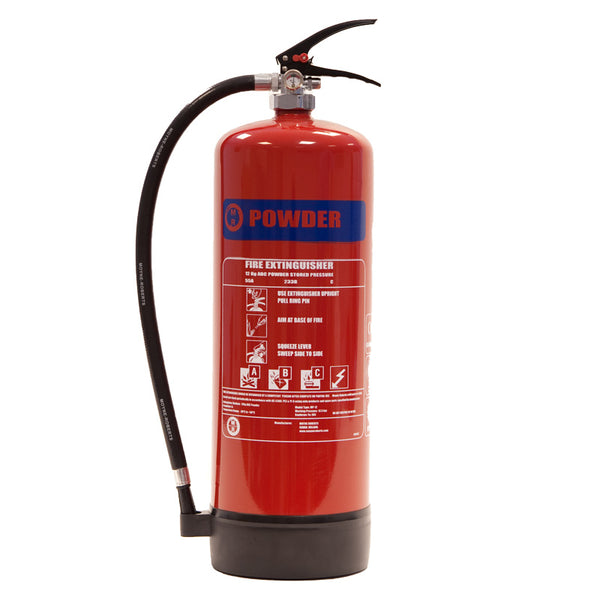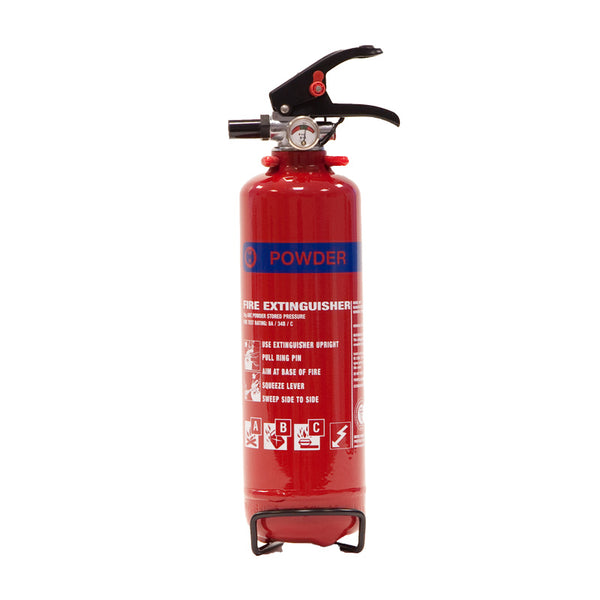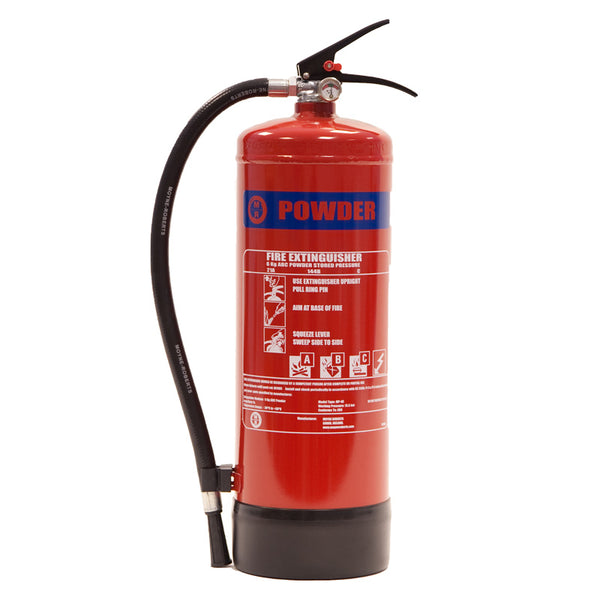Fire safety is a paramount concern for any responsible individual or organisation. While there are various types of fire extinguishers designed to combat specific types of fires, dry powder fire extinguishers stand out as versatile tools in the fight against various fire hazards. In this guide, we'll explore what dry chemical fire extinguishers are, how they work, and the types of fires they are best suited for. We will explain the different types of dry powder extinguishers and when each should be used.
What Are Dry Powder Fire Extinguishers?
Dry powder fire extinguishers, also known as dry chemical extinguishers, are crucial to fire safety. They contain a specially formulated chemical compound in the form of a dry powder, which is pressurised with nitrogen.
How Do Dry Powder Fire Extinguishers Put Out Fires?
Spraying dry powder onto the fire has a knockdown effect on the flames. The powder is a chemical compound designed to react to the heat from the fire. The heat causes the powder to expand and create a barrier between the fire and the oxygen in the air. This barrier effectively suffocates the flames by cutting off their oxygen supply, ultimately bringing the fire under control.
What Are Dry Powder Fire Extinguishers Used For?
Dry powder fire extinguishers are incredibly versatile and can be used on a variety of fires, making them valuable additions to any fire safety plan. However, using them only for the correct type of fire is vital. Within the range of dry powder fire extinguishers, there are options for Class A, B, C, and D fires, providing flexibility for various potential fire risks. Keep in mind that not all dry powder extinguishers work for all types of fires, so it's essential to match the extinguisher to the intended class of fire. In the following sections, we will delve deeper into the different types of dry powder fire extinguishers, their specific applications, and their advantages and limitations so you can make informed decisions about your fire safety equipment needs.
Types of Dry Powder Fire Extinguisher
There are several different types of dry powder extinguishers. Each type is uniquely designed for extinguishing specific types of fire. Powder extinguishers are normally described by the type of fire they are designed to control. For example, BC dry powder extinguishers are for use on Class B and Class C fires.
BC Powder Fire Extinguishers
BC fire extinguishers are the standard type of dry powder fire extinguisher. They are filled with sodium bicarbonate or potassium bicarbonate and are used for liquid fires (Class B) involving burning petrol, solvents, oils, etc. and Class C fires involving flammable gases. The more versatile ABC powder extinguishers have generally superseded BC options. Like all powder extinguishers, they leave a residue which may cause damage to sensitive electrical equipment after use.
ABC Powder Fire Extinguishers
ABC powder extinguishers are the most used and most popular multipurpose powder fire extinguishers. As the name implies, they can be used on class A (burning solids), B (liquid fires) and C ( Gases) fires. ABC fire extinguishers are filled with mono-ammonium phosphate powder.
Limitations of ABC Powder Fire Extinguishers
Although extremely versatile, ABC powder fire extinguishers are not a “catch-all” solution. As with BC extinguishers, the powder leaves a residue that could cause damage to electrical equipment. (Use CO2 extinguishers for electrical fires). They are also ineffective on cooking oil and fat fires. A special Wet Chemical extinguisher has been introduced specifically for these Class F fire risks in commercial kitchens and food processing areas. ABC dry powder does not extinguish metal fires where the specialist L2 and M28 extinguishers should be used.
Monnex Dry Powder Extinguishers
Monnex Powder is a superior dry powder based on a potassium bicarbonate-urea complex suppressant developed for Class B and C liquid and gas fires. They have superior knockdown performance and are used where flammable liquids and gases are frequently used or stored, such as fuel stores, garages, motor racing events, and airports. Monnex Powder extinguishers are more expensive than standard ABC powder equivalents, but their superior performance can prove invaluable in these particularly hazardous environments.
M28 and L2 Powder
M28 and L2 special powder extinguishers are designed specifically to fight combustible metal fires (Class D), such as sodium, magnesium and aluminium, typically in the form of machined swarf or powder. The M28 powder is not effective on burning Lithium. L2 powder is also designed for Class D metal fires but, unlike M28, is also effective on Lithium fires. These types of extinguishers are equipped with a special low-velocity applicator to ensure the powder is applied gently and efficiently without the risk of the discharge pressure spreading or splashing the burning metal.
Automatic Dry Powder Fire Extinguishers
Automatic dry powder fire extinguishers are versatile and designed for fixed, continuous fire protection. With coverage for areas up to 20 cubic meters, automatic dry powder extinguishers are suitable for Class A, B, C, and electrical fires. They come equipped with a 68°C red bulb automatic sprinkler and a pressure gauge for easy inspection. These fully refillable extinguishers are ideal for applications in trucks, small and large boats, and engine/plant rooms. Their automatic activation system ensures rapid response, making them a valuable asset for enhanced fire safety in various environments.
Buy your automatic dry powder fire extinguisher:
- 2kg automatic ABC fire extinguisher
- 6kg automatic powder extinguishers
- 12kg automatic dry powder fire extinguishers
Buy Dry Powder Fire Extinguishers
Dry powder fire extinguishers are a valuable addition to your fire safety toolkit, providing protection against various fire risks. However, it's crucial to select the right type for your specific needs and be mindful of their limitations.
To ensure your business premises is fully prepared to handle fires safely and effectively, explore our comprehensive range of fire extinguishers. We offer a diverse selection that covers all fire classes and comes in various sizes to suit your requirements. Don't wait; shop our fire extinguisher range today or consult with one of our knowledgeable fire safety experts to learn more about making your premises safer.




